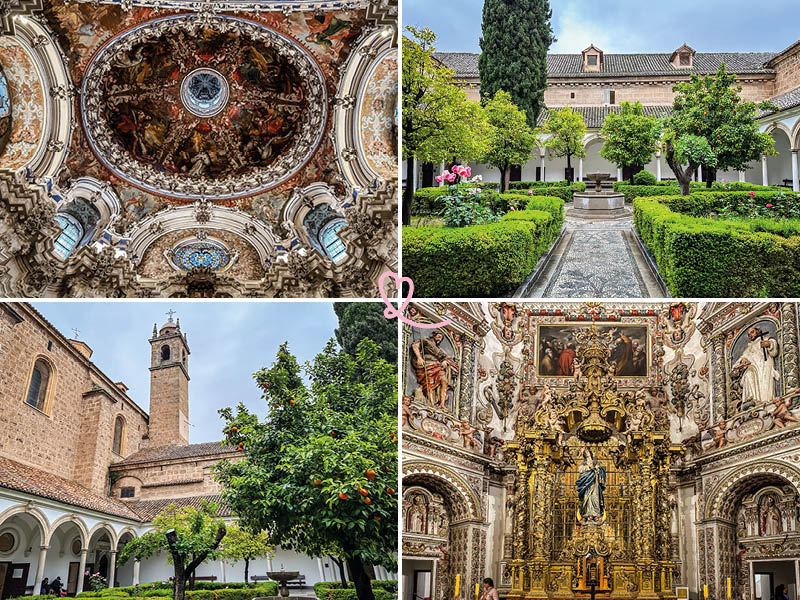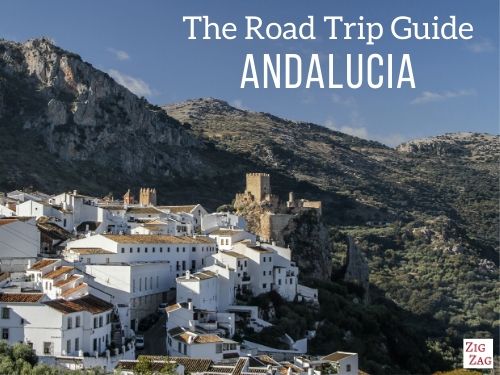Visiting Granada? Don’t miss the Monastère de la Cartuja! This jewel of Andalusian Baroque offers a striking contrast between its austere façade and its dazzling interiors. We were fascinated by the decorative richness of this exceptional monument, revealing treasures of sacred art at every turn.
In this article, you’ll find some useful tips to help you prepare for your visit and have a wonderful time!

This opinion is completely independent, based on our experiences. We made our own choices, visited the area anonymously, and paid our bills in full.
Why visit the Monastery of La Cartuja (Granada)?
Is the Cartuja Monastery worth it? Our opinion:
Yes, the Monastery of La Cartuja is definitely worth a visit. This former Carthusian monastery is one of the finest examples of Andalusian Baroque art. We were particularly impressed by the decorative richness of its interior spaces, which contrast with the sober exterior characteristic of the Carthusian order.
This is one of Granada’s best activities.

Why is the Monasterio de la Cartuja famous?
The monastery is renowned for its incredible Baroque décor, making it an exceptional artistic gem. It also plays an important role in Granada’s religious history, having been home to the Carthusian community for three centuries.
The building bears witness to the evolution of architectural styles from the 16th to the 18th century, and is an outstanding example of Andalusian sacred art.

Our favorite
We were captivated by the fresco above the tabernacle. The richly decorated walls frame paintings by Antonio Palomino depicting themes from the Old Testament. The figure of Saint Bruno appears as a Hercules holding the monstrance over the world, accompanied by the Trinity with Mary and John the Baptist, surrounded by choirs of angels and saints in a composition of breathtaking beauty.

WHERE TO STAY IN Granada
Our favorites: hotels and neighborhoods
Downtown
Hotel Luna Granada Centro – See prices, photos and availability
Hotel Corrala del Realejo – See prices, photos and availability
At the Alhambra
Alhambra Palace – See prices, photos and availability

See our complete selection of the best hotels in Granada
History in brief
The Monastère de la Cartuja has a rich history:
- 1084: Founding of the Carthusian order, advocating simplicity and poverty.
- 1514: Arrival of the first Carthusian monks in Granada, from Cartuja del Paular (Castile).
- 1516: Construction of the monastery begins under the direction of Fray Alonso de Ledesma. The work lasted three centuries.
- 1545: The monastery is officially integrated into the Carthusian order.
- 1603: Painter Juan Sánchez Cotán joins the monastery, leaving behind a major body of work including still lifes and cycles of religious painting.
- 1662: Completion of the church, one of the monastery’s great Baroque wonders.
- 1835: The monastery is abandoned due to deamortizations; many convents and monasteries close at this time.
- 1842: Destruction: the cloister and monks’ cells disappear, as does the prioral house.
- 1931: La Cartuja monastery is declared a Historic Monument and a Site of Cultural Interest.
A model will help you understand the different eras of the monastery.

How to get there: Monastère de la Cartuja, Granada
Where is the Monastery of La Cartuja?
The Monastery of La Cartuja is located at P.º de Cartuja, s/n, in the Beiro district of northern Granada.

RENT A CAR IN Andalucia
- Compare prices on our preferred platform: DiscoverCars – one of the best rated sites.
- Choose a compact car, as some villages have very narrow streets!
- Think ofcomprehensive insurance for the same reason
- Book early for choice.

How to get there?
Although the monastery is a 30-minute walk from the city center, we recommend you get there by car or bus (line 8, “Henriquez de Jorquera 18” stop). To plan your public transport route, visit the official transport network website here.

Parking
The monastery has no private parking facilities. However, you’ll find plenty of parking close to the building. As the area is less busy than the historic center, parking is generally easy in the vicinity.
DISCOVER Granada
- Things to do in Granada
- Best hotels
- Best restaurants
- Museums
- Itineraries: 1 day – 2 days – 3 days

Useful tips: duration, schedules, eating…
Best time to visit
As the Monastère de la Cartuja is quite far from the main tourist routes, you won’t encounter any particular difficulties due to the crowds. This privileged location means you can enjoy a serene visit at any time of day.

Length of visit and main difficulties
Allow at least 1 hour to fully appreciate the profusion of artistic details. The site presents no major difficulties, but there are a few steps up to the monument, making access difficult for wheelchairs. There are toilets and a store on site offering souvenirs and snacks.
Advice on how to visit
We recommend that you follow the route marked out by the mediation service and listen to the audio guide tracks. This will enable you to grasp the artistic and historical richness of the site in a progressive and structured way.
Don’t miss the two oratories, Madeleine and de l’Immaculée, both of rare elegance!

PLAN YOUR DREAM TRIP TO andalucia
All the information you need for your trip:
- 7 maps that make planning easier
- + 150 pre-selected locations
- Practical advice
- 300+ photos to help you choose

Visiting with children
Although there’s no specific tour or activity for children, the little ones are sure to be impressed by the richness of the Baroque décor!

Schedules and rates
The monastery is open Sunday to Friday from 10am to 6:30pm and Saturday from 10am to 12:15pm and from 3pm to 5:30pm. Check the official website for updates here.
Rates:
- Full price: €6
- Free for children under 12
Guided tours
An audioguide is available to download free of charge from the reception desk.
Several signs indicate the stages of the audio tour to be followed.
We also appreciated the many explanatory labels (in Spanish and English) explaining the notable masterpieces.

Catering
There are no restaurants in the immediate vicinity of the monastery. For your meals, we invite you to consult our article on the best restaurants in Granada, available here.
Behind the sober exterior, an intriguing monastery
The austere façade of Granada’s Monastery of La Cartuja
From the moment you arrive, the entrance to the Chartreuse de Grenade is striking in its majestic simplicity. In front of you, a wide cobbled forecourt leads to a double staircase in grey Sierra Elvira marble, a 17thᵉ century work by Cristóbal de Vílchez. The floor below features one of the finest examples of Grenadian paving from this period.
We were struck by the austere, massive facade of bare stone, which seems to close the building in on itself. In the center, a XVIᵉ century portal, designed by Juan García de Prada, marks the symbolic boundary between the secular world and the monastic universe.
Finally, the church’s neoclassical façade, completed in the late XVIIIᵉ century by architect Joaquín Hermoso, stands sober and rectilinear.

Take a moment to look up at the pediment: a small marble sculpture depicts Saint Bruno, founder of the Carthusian order. Draped in a white robe, a symbol of purity, he alone embodies the spirit of the Chartreuse. The deliberately sober statue exudes contemplation. Its elegant folds, delicate hands and almost ecstatic facial expression reflect the Carthusian vocation: a life of silence, solitude and prayer.

The compás and the cloister: the heart of monastic life
The small cloister, a masterpiece of the XVIIᵉ century, is the true center of the Chartreuse.
With its harmonious arcades, it structures community life by linking the monastery’s various outbuildings. A place of meditation and daily circulation, it once housed a rich series of paintings, now spread over other rooms.
We really appreciated its serenity and the beauty of its varied vegetation, from roses to orange trees!

Around the cloister are the main communal rooms: the refectory, the profundis room, the lay chapter and the monks’ chapter house. All are striking in their deliberate sobriety, a reflection of the Carthusian ideal of simplicity. These unostentatious rooms were designed to encourage silence, humility and meditation, in complete contrast to the baroque pomp of the liturgical spaces.

Dive into a dazzling Baroque universe
La Cartuja church: a visual shock
The Chartreuse church is without doubt one of the monastery’s greatest treasures. Its construction, begun by Cristóbal de Vílchez in the mid-16ᵉ century, was not completed until 1662, reflecting a long and ambitious project. As soon as you enter, the unique nave impresses with its finely decorated cross vault and elegant composition.
The space is organized into three distinct parts: the worshippers’ area, separated by a low grid, the laity’s area, then the monks’ choir. The latter, reserved for the religious community, is distinguished by a sumptuous gilded partition, adorned with doors in marquetry and Venetian crystal: a veritable manifesto of Baroque splendour!

We loved the stark contrast between the white stuccoed walls and the bright gilding and paintings that bring them to life. Among these works, two paintings by Juan Sánchez Cotán are particularly eye-catching: The Rest during the Flight into Egypt on the left, and The Baptism of Christ on the right, both made in the XVIIᵉ century.
Note also the black-and-white checkerboard floor for added contrast!

The sacristy and the sagrario: the Baroque jewels of the Monastery of La Cartuja
Behind the main altar is the astonishing Sagrario chapel. At its center is a camarín, a small, raised reliquary chapel designed to house the tabernacle and magnify the presence of the Blessed Sacrament. Created in the early XVIIIᵉ century by Francisco Hurtado Izquierdo, a master of Andalusian Baroque, the space was designed with the help of the finest craftsmen of his time.
Right from the entrance, the profusion of materials strikes the eye: polychrome marble, gleaming gilding, sculptures, paintings, canopies and curtains combine to create a striking theatricality. In the center, the marble tabernacle rises like a gigantic stone monstrance, inviting visitors to raise their eyes to heaven. Everything here suggests movement, elevation and transcendence.

The tour ends with the sacristy, begun in 1732, probably as a project by Francisco Hurtado Izquierdo and continued by José de Bada. Conceived as a true Baroque temple rather than a mere utility room, its architectural boldness is astonishing. The walls are covered with abstract, geometric shapes carved in stucco, which unfold in a continuous, harmonious movement. The central void, the immaculate whiteness of the surfaces, the rhombic design of the floor and the subtle interplay of volumes create an impression of depth and lightness.
The whiteness of the plaster moldings blends with the veined marble panelling and the altarpiece, gaining in intensity as it rises towards the filigree vault, similar to the keel of a ship. The light, filtering through behind the cornice, gently descends on the scrolls adorning the walls, reinforcing the sensation of spiritual elevation. Unlike the iconographic decorations of the church or Sagrario, the sacristy adopts an abstract language, intended as a form of homage to God through the pure beauty of its forms.

A monastery dedicated to art
In the church: beyond the Baroque decor, remarkable frescoes and paintings
While the brilliance of the stucco, marble and gilding immediately catches the eye, the paintings nestled in the abundant decorations are not to be missed. Some may go unnoticed, but are well worth a closer look. We particularly liked Palomino’s fresco above the tabernacle (our favorite), and also spotted Bocanegra’s series of virgins. This is the second most important series after the one painted by his master, Alonso Cano, for Granada Cathedral.
We loved the naturalistic scenes and bright colors!

Treasures scattered throughout the common rooms
We also invite you to take the time to observe the other nuggets hidden in the common areas. In the refectory, take a look at The Last Supper (1615) by Juan Sánchez Cotán, Carthusian monk and master of realism. The artist plays with perspective and the architecture of the room: the windows, floor and walls of the painting extend those of the refectory, blurring the boundary between painting and reality. The apostles, caught in their turmoil after the announcement of the betrayal, contrast with the foreground scene of a cat and a dog fighting over a fish. Finally, look up: just above, a trompe-l’œil cross by the same artist completes the dazzling illusion.

The cloister chapels: veritable artistic showcases
What’s striking about La Cartuja is that art is everywhere, even in the corridors, like an invitation to contemplation. Take the cloister chapels: the first houses a delicate Virgin of the Rosary by José Risueño, one of the great masters of Granada Baroque. The serenity of Mary, wrapped in a toga, contrasts with the energy of the Infant Jesus, whose gaze draws the visitor into the scene. The care taken with fabrics and colors testifies to the artist’s refinement.
The second chapel features marquetry furniture and a small pavilion for displaying the Blessed Sacrament. The third, by the García brothers, is a stunning example of the expressive power of local artists.

Subscribe to our Newsletter
- Get away from it all with Region Lovers’ beautiful destinations!
- Once a month
- Advertising-free
Frequently asked questions
What’s the difference between La Cartuja and Granada’s Monasterio de San Jerónimo?
These two Granada monasteries are very different in history and style. La Cartuja (Charterhouse) was founded in the XVIᵉ century by Carthusian monks. The Monasterio de San Jerónimo was built at the same time by the Hieronymite order. It is a landmark of the Spanish Renaissance, known for its richly decorated church and the tomb of the Gran Capitán (Gonzalo Fernández de Córdoba).

PLAN YOUR TRIP TO Andalusia
Inspiration

Practice
- Where to stay in Andalucia
- Best luxury hotels in Andalusia (coming soon)
- Rent a car in Andalucia
- Itineraries: 3 days – 4 or 5 days – 1 week – 10 days – 2 weeks (coming soon)






